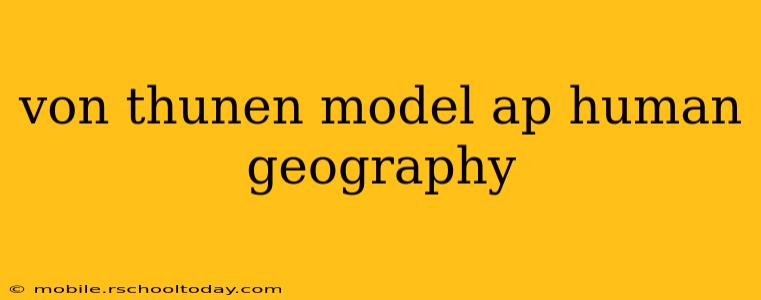The Von Thünen model, a cornerstone of agricultural location theory in AP Human Geography, provides a spatial explanation for the distribution of agricultural activities around a central market. Developed by German economist Johann Heinrich von Thünen in 1826, this model, while simplified, offers valuable insights into the interplay between land use, transportation costs, and market forces. This article will explore the model's key components, its limitations, and its continuing relevance in understanding agricultural patterns today.
Understanding the Core Principles of the Von Thünen Model
At its heart, the Von Thünen model depicts concentric rings radiating outwards from a central market (typically a city). Each ring represents a different type of agricultural activity, dictated primarily by the perishability of the product and its transportation costs. The model assumes a flat, uniform land surface with no physical barriers, and equal access to the market from all directions. This idealized scenario allows for a focused analysis of the economic factors influencing land use.
The Rings Explained:
-
Ring 1: Intensive Agriculture and Dairying: Closest to the market, this ring features highly perishable goods like dairy products, fruits, and vegetables requiring quick transportation to minimize spoilage. High land values reflect the premium paid for proximity to the market.
-
Ring 2: Forestry and Timber: The second ring typically houses forestry operations. While wood is less perishable than dairy, it's still bulky and expensive to transport over long distances. The proximity to the market balances the transportation costs.
-
Ring 3: Extensive Field Crops: This ring is dedicated to less perishable crops like grains (wheat, barley, etc.) that are easier and cheaper to transport. Land values are lower due to increased transportation costs compared to the inner rings.
-
Ring 4: Ranching and Livestock Grazing: The outermost ring is reserved for extensive livestock grazing and ranching. These activities require large areas of land and are less sensitive to transportation costs, as livestock can be moved to market over longer distances.
Beyond the Basic Model: Factors Influencing Location
While the original model presents a simplified view, several factors can modify the arrangement of agricultural activities:
1. Transportation Costs:
The relative cost of transporting different products significantly influences their location within the rings. Improvements in transportation technology (e.g., refrigerated trucks, railroads) can extend the reach of perishable goods, potentially blurring the boundaries between rings.
2. Land Value:
Land closer to the market commands higher prices due to increased demand. This competition for land influences the choice of agricultural activities. Higher value lands are used for high-value, intensive agriculture.
3. Technology and Innovation:
Technological advancements in farming techniques, preservation methods, and transportation can alter the optimal location of certain agricultural activities. For example, improved refrigeration allows for the transportation of perishable goods over longer distances.
4. Government Policies and Regulations:
Government policies such as subsidies, trade agreements, and environmental regulations can significantly impact agricultural land use, potentially overriding the principles of the Von Thünen model.
Limitations and Criticisms of the Model
While insightful, the Von Thünen model has inherent limitations:
-
Oversimplification: The model's assumption of a flat, uniform landscape and equal access to the market ignores the impact of physical features (mountains, rivers), soil variations, and variations in climate.
-
Technological Advancements: The model doesn't fully account for the impact of technological advancements in transportation, preservation, and agricultural production which have significantly changed the spatial distribution of agricultural activities.
-
Market Demand Fluctuations: The model doesn't account for fluctuations in market demand and prices, which significantly influence agricultural production decisions.
Conclusion: Relevance in the Modern World
Despite its limitations, the Von Thünen model remains a valuable tool for understanding the basic principles governing the location of agricultural activities. It provides a foundational framework for analyzing the interplay between transportation costs, land values, and market forces in shaping agricultural land use. While the reality is far more complex than the idealized model suggests, understanding its core principles offers valuable insight into the spatial dynamics of agricultural production and distribution in the modern world. By acknowledging its limitations and considering other influential factors, we can use the Von Thünen model as a springboard for a more nuanced understanding of contemporary agricultural landscapes.
